Choose the correct order of classification from most inclusive to exclusive.
Domain-Kingdom-Phylum-Class-Order-Family-Genus-Species
Biodiversity in a particular ecosystem.
A. is the total number of species in that ecosystem
B. includes the variability of the individual genes
C. impacts the function of the ecosystem in which the species live
D. All of the choices are correct.
All of the choices are correct.
Which listing correctly indicates a sequence of increasing biological organization?
atom, molecule, organelle, cell
Living and nonliving entities share some characteristics. Which statements are TRUE and which are FALSE about both living and nonliving entities?
Both living and nonliving entities exhibit homeostatic controls
False
Which of the following concepts is NOT one of the unifying theories of biology?
Life may arise through spontaneous generation.
A cell is to a tissue as an atom is to a:
molecule
Some members of Daphnia, a water flea, have a genetic mutation that causes them to prefer warmer environments. These members reproduce and pass these genetic changes to their offspring. The next generation will occupy warmer environments not previously occupied by this species. This is an example of:
adaptation
Which of the following does NOT represent homeostasis?
Energy is captured by plants, then transferred to consumers and decomposers, and eventually lost as heat.
Which definition best describes a population?
the members of a species in a given area
(T or F) The classification system most commonly used by biologists today contains five domains.
False
Living organisms on Earth share many common characteristics. Which statements are TRUE and which are FALSE about nearly all living things?
Living things are composed only of organic elements, whereas nonliving things are made up of inorganic elements
False
(T or F) Extinction can occur if a species is unable to adapt to a changing environment.
True
Which of the following terms best describes the collection of scientific data through observation in the field, such as observing the behavior of birds?
descriptive research
Which of the following organisms is NOT ultimately dependent on the sun as a source of energy?
All of the choices ARE ultimately dependent on the sun.
Which of the following domains contains the most primitive prokaryotes that live in extreme environments?
Archaea
Which of the following is/are an atom, an isotope and an ion?
H+
An atom's atomic mass is best described as the mass of
protons and neutrons it contains.
Which statement is NOT true about subatomic particles?
All electrons in an atom contain the same amount of energy.
Which type of covalent bond is the strongest?
triple
Which of the following elements is NOT one of the six most common elements in living organisms?
iron
Which substances are on the basic side of the pH scale?
baking soda, oven cleaner & human blood
If you place the corner of a paper towel into a droplet of water the water moves across the paper towel. Which of the following would explain the movement of the water?
both cohesion and adhesion
Which term refers to the attraction to water molecules?
hydrophilic
Which statement is NOT true about covalent bonds?
Covalent bonds form when an electron is completely lost or gained from an atom.
Which is NOT true about the electrical charges in chemistry?
In an atom, the number of protons and neutrons must be equal.
(T or F) Which of the following statements is/are true about the pH scale?
The scale ranges from 1 to 15.
False
The electrons are unequally shared in _______, and transferred in __________.
CH4, Na+Cl-
All of the following are examples of damage caused by acid deposition from rain EXCEPT
increased agricultural yields
An orbital is best described as
the volume of space in which electrons are most often found.
A polysaccharide is a polymer made up of which kind of monomers?
simple sugars
Which carbohydrate is found in the exoskeleton of insects and crabs?
chitin
Which functional group will attach to a hydrocarbon chain to form alcohol?
hydroxyl
Which carbohydrate is found in the cell walls of plants?
cellulose
Saturated fatty acids and unsaturated fatty acids differ in:
all of the choices are differences between saturated and unsaturated fatty acid
Which of the following are structural carbohydrate molecules?
cellulose and chitin
A lipid is a polymer made up of which kind of monomers?
fatty acids and glycerol
(T or F) ATP is a protein that supplies energy to the cell.
False
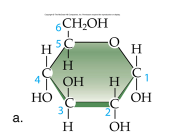
Identify this molecule:
carbohydrate
What is the molecular formula for 5 glucose molecules?
C30H50O25
(T or F) Carbon can form covalent bonds with as many as four other atoms.
True
Organic molecules are those that contain at least
carbon and hydrogen.
(T or F) Waxes consist of a glycerol bonded to three long-chain fatty acids.
False

Choose the Figure that depicts polymer synthesis.
Figure 1
A dehydration reaction can also be called a (an) _________ reaction since it forms water.
condensation
Which carbohydrate is used in the liver for energy storage?
glycogen
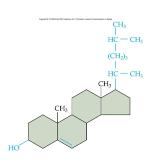
Identify the following molecule:
cholesterol
Which of the following functional groups represents sulfhydryl?
SH
Which one is NOT one of the properties of water?
the frozen form is more dense than the liquid form
Which of the following would NOT be a molecule used for energy storage?
chitin
A peptide bond is found in which type of biological molecule?
Protein
Which of the following gives rise to both lysosomes and vesicles?
Golgi apparatus
DNA is housed within the nucleus, but the mRNA code needs to leave in order to be translated into a protein. How does the mRNA code leave the nucleus if the nucleus is surrounded by the nuclear envelope?
The nuclear envelope contains pores that allow the mRNA to exit through.
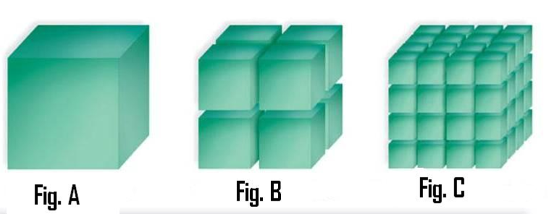
Figures A, B and C to answer Questions 40 - 44. Figure A is an 8-cm. cube. Figure B is eight, 4-cm cubes. Figure C is sixty-four, 2-cm cubes.
Diagram
What figure has the greatest surface area : volume ratio?
Figure C
Which of the following organelles is found within an autotrophic, eukaryotic cell?
chloroplast
What is the smallest unit of living matter?
cell
The plant cell's central vacuole
A. provides the plant cell with support.
B. stores nutrients and cellular waste products.
C. is a reservoir for water.
D. All of the choices are correct.
All of the choices are correct.
Of the following, which is NOT associated with the mitochondria?
stroma
Which organelle is primarily responsible for the breakdown of lipids within the cell?
peroxisome
Which statement is NOT true about bacteria?
Bacteria contain membrane bound organelles.
Which of the following gives rise to both lysosomes and vesicles?
Golgi apparatus
Which cellular organelle is the most prominent?
nucleus
Which of the following features is unique to bacterial cells?
nucleoid region

Use Figures A, B and C to answer Questions 40 - 44. Figure A is an 8-cm. cube. Figure B is eight, 4-cm cubes. Figure C is sixty-four, 2-cm cubes.
Diagram
What Figure has the greatest volume (height x width x length x number of cubes)?
All of these have the same volume.
Chloroplasts are to ____________ as ___________ are to aerobic respiration.
photosynthesis, mitochondria
Which process is responsible for moving cellular wastes across the cell membrane?
exocytosis
Active transport
requires an input of ATP.
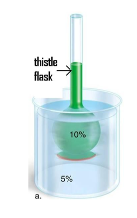
A 10% glucose solution is placed in the thistle tube. The thistle tube is placed in a beaker that contains a 5% glucose solution. Where is the highest concentration of water found?
In the 5% solution
Which type of junctions will create a solid barrier to prevent molecules from moving between the cells?
tight
A major chemical that regulates the fluidity of animal cell membranes by stiffening the membrane at higher temperatures and preventing the membrane from freezing at lower temperature is
A. cholesterol
B. lipid in nature.
C. a steroid.
D. All of the choices are correct.
All of the choices are correct.
Proteins in a membrane are:
A. peripheral if they are on the inside surface held in place by the cytoskeleton.
B. integral if they are embedded in the membrane and protrude from both surfaces of the bilayer.
C. integral if they protrude from only one surface of the bilayer.
D. All of the choices are correct.
All of the choices are correct.
If a living plant were moved from a freshwater aquarium to a saltwater aquarium, which of the following would occur?
The plant's cells would lose water and plasmolysis would occur.
Which statement is true about the plasma membrane?
The movement of proteins and phospholipids can occur sideways within the plane of the membrane.
Whether a molecule can cross the plasma membrane depends upon
A. the size of the molecule.
B. the shape of the molecule.
C. the chemical properties of the molecule.
D. the charge of the molecule.
E. All of the choices are correct.
All of the choices are correct.

In the cell pictured, there is no net movement of water. The amount leaving the cell and entering the cell is the same. In what type of environment is this cell found?
isotonic
Which cell junction will allow the movement of molecules between two plant cells?
plasmodesmata
Which of the following is NOT associated with animal cells?
plasmodesmata
(T or F) In the sodium-potassium pump, sodium is transported out of the cell and potassium is transported into the cell as ATP is broken by a membrane protein.
True
Which is the best definition of osmosis?
The movement of water across a semi permeable membrane from an area of higher water concentration to an area of lower water concentration.
Which of the following situations is most likely to produce a heart attack?
The gap junctions have collapsed and they do not allow the correct flow of ions from one cell to the next.
Photosynthetic pigments capture _____ of the solar energy that reaches the earth.
less than 2%
Which correctly describes the light-independent reactions?
CO2 is reduced.
CO2 fixation occurs when CO2 combines with _____.
ribulose bisphosphate
In photosynthesis:
carbon dioxide is reduced to sugar.
The endproducts of photosynthesis are:
Glucose and O2
_______ plant pigments absorb light in the violet-blue-green range and therefore appear as shades of yellow and orange.
Carotenoid
About 20-50% of the protein content in chloroplasts is _____, which speeds up CO2 fixation.
RuBP carboxylase
C4 plants fix CO2 to _____.
PEP (phosphoenolpyruvate)
The energy and electrons needed for carbohydrate synthesis during the Calvin Benson Cycle are supplied by:
NADPH and ATP
The oxygen given off by photosynthesis comes from ___________.
H2O
This product of fermentation is lethal to the cells that produce it:
Alcohol
Which of the following statements correctly describes glycolysis?
Glycolysis produces two molecules of pyruvate.
All of the following statements about catabolism are true EXCEPT:
A. Catabolism breaks down larger molecules into smaller molecules.
B. Catabolic pathways tend to be exergonic.
C. Photosynthesis is catabolic.
D. Catabolism drives anabolism.
Photosynthesis is catabolic.
If oxygen is not available the pyruvates produced by glycolysis are fed into:
fermentation.
There is/are _____ pyruvate molecule(s) produced per glucose molecule during glycolysis.
two
During fermentation, _____ is regenerated and returns to glycolysis to pick up more electrons.
NAD+
Which of the following citric acid cycle byproducts is disposed of by our respiratory system when we exhale?
CO2
Plants are able to synthesize all of the amino acids they need. Humans are only capable of synthesizing 11 amino acids with the others termed _________.
essential amino acids
Iron-containing proteins that are part of electron transport chains are:
cytochromes
When NADH produced during the preparatory reaction and citric acid cycle delivers electrons to the electron transport system, _____ ATP is/are produced.
3
Which statement below lists the correct steps for binary fission?
- attachment of chromosome to the plasma membrane, 2. enlargement of cell volume, 3. DNA replication occurs, 4. cell elongates and chromosomes are pulled apart, 5. a new cell wall and plasma membrane divide the cell in half
Interphase
A. occupies the majority of the cell cycle
B. includes G1, S and G2 stages
C. results in an increase in cell size
D. all of the above
E. none of the above
All of the above
Apoptosis
A. is programmed cell death.
B. is a process that acts to decrease the number of somatic cells.
C. frees the fingers and toes of the human embryo from their ‘webbed' structure to independent structures.
D. All of the choices are correct.
All of the choices are correct.
(T or F) Viruses and chemical exposure can cause mutations in proto-oncogenes which can lead to cancer.
True
If a parent cell has 48 chromosomes, how many chromosomes will each daughter cell have after mitosis and cytokinesis occurs?
48 chromosomes
What is the result of a cell not meeting the criteria to pass the G1checkpoint?
A. The cell cycle halts.
B. The cell may enter the G0 stage.
C. The cell may undergo apoptosis.
D. All of the above.
E. None of the above.
All of the above.
The critical checkpoints that control the cell cycle are the:
G1 to S stage and G2 to M stage.
(T or F) Contact inhibition stops normal cells from dividing when they come in contact with neighboring cells, but this is not functional in cancer cells.
True
Which represents the correct sequence of stages in the cell cycle?
G1, S, G2, M
The region that contains the genetic information in a bacterial cell is called the
nucleoid
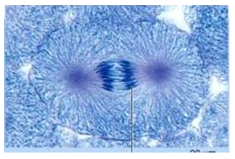
What phase of mitosis is pictured?
anaphase
Which is NOT correctly associated with cancer?
The disorganized mass of cells is encapsulated and does not invade adjacent tissue.
(T or F) The enzymes that bring about apoptosis are:
called caspases.
True
Which of the following is NOT true about cancer cells?
They exhibit contact inhibition.
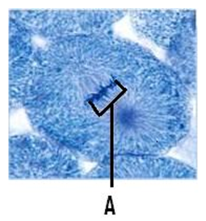
What is (are) the structures designated by the letter ‘A'.
chromosomes
The function of mitosis is:
A. growth of the organism and tissue repair.
B. to ensure that each new cell receives a complete set of genetic information.
C. asexual reproduction in some species.
D. All of the choices are correct.
All of the choices are correct.
The haploid (n) number of chromosomes for a human being is
23
The diploid (2n) number of chromosomes for a human being is
46
Cancer cells require many nutrients, which are supplied by blood vessels. The growth of new blood vessels to cancerous tissue is called:
angiogenesis
Apoptosis refers to cell death and
can be programmed and is essential to normal development.
What occurs in anaphase?
Chromosomes move to opposite poles.
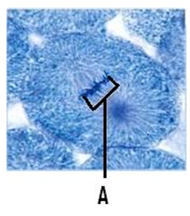
What phase of mitosis is pictured?
metaphase
Although cancer may originate in many regions of the body, many patients die from cancerous growth in the lungs, lymph glands, or liver. This is most readily explained as
metastasis occurring more commonly in organs that have a filter effect.
Which of the following is NOT true concerning mitosis?
Animal cells form a cell plate during cytokinesis while plant cells do not.
Cytokinesis in plant cells differs from this process in animal cells because
the Golgi apparatus produces vesicles that migrate along microtubules and fuse to become a cell plate.
To what does the term chiasma refer?
a structure that holds together homologues during crossing-over
Which is NOT true about daughter cells of mitosis or meiosis?
In meiosis, the daughter cells are genetically identical.
Which of the following statements is true about the life cycle of animals?
The gametes are the haploid phase of the animals life cycle.
If the diploid number of chromosomes for an organism is 52, what will the haploid number of chromosomes be?
The gametes are the haploid phase of the animals life cycle.
If the diploid number of chromosomes for an organism is 52, what will the haploid number of chromosomes be?
26
Where in the human male does spermatogenesis occur?
testes
Why do polar bodies form?.
They allow a reduction in chromosomes while preserving most of the cytoplasm for one egg.
Species X reproduces asexually by fission and species Y reproduces sexually. Consider that all other relevant characteristics are similar between these species. When the environment changes, then
species Y should have a better chance of surviving than species X.
(T or F) Jacobs Syndrome, XYY, results from nondisjunction during spermatogenesis.
True
All of the following are true concerning Down Syndrome EXCEPT
chances of a woman having a child with Down Syndrome decreases with her age
During which stage of meiosis does the homologue separation occur?
anaphase I
Sources of genetic variation in a sexually reproducing population include(s) which of the following?
A. crossing over in Prophase I of meiosis
B. independent assortment in Metaphase I of meiosis
C. fertilization
D. All of the choices are sources of genetic variation.
E. None of the choices are sources of genetic variation.
All of the choices are sources of genetic variation.
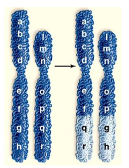
The following picture depicts which of the following changes in chromosome structure.
translocation
Which of the following events occurs during prophase I but does not occur during prophase of mitosis?
crossing over
Meiosis occurs during all of the following EXCEPT
pangenesis.
Which of the following steps would NOT lead to variation of genetic material?
crossing over of sister chromatids
It could be said that males are able to provide gametes with more genetic diversity than females for reproduction. One main reason would be:
Spermatogenesis in males results in four functional sperm while oogenesis in females results in only one egg and three structures that contain genetic information that is lost when they disintegrate.
Which of the following statements is correct about the chromosomal position during mitosis and meiosis?
During metaphase of mitosis the duplicated chromosomes are at the metaphase plate while during metaphase I of meiosis the bivalents are present at the metaphase plate
Characterize the following statements about changes in chromosome
number and structure as True or False.
Monosomy occurs
when an individual has only one of a particular type of chromosome.
True
If a sperm cell contains 8 chromosomes, it comes from an animal that has ______ chromosomes.
16
During which stage of meiosis does crossing-over occur?
prophase I of meiosis I
During which stage of meiosis are the bivalents arranged along the equator?
metaphase I

The following picture depicts which of the following changes in chromosome structure.
duplication
The cell formed through fertilization of an egg by a sperm is called a/an
zygote
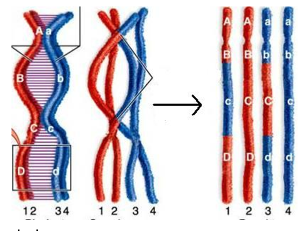
Study the diagram to answer the following questions.
Diagram
What process is occurring in this diagram?
crossing over
The polar body is
a nonfunctional cell rudiment formed at the same time as an egg cell.